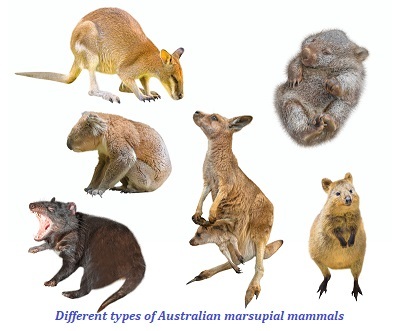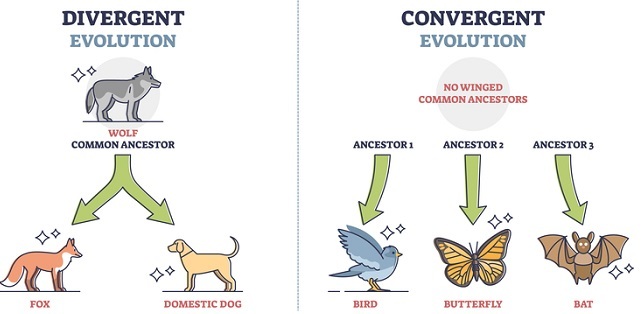

Evolutionary change can occasionally take place in two or more unrelated or distantly related species due to comparable environmental influences. As a result, unrelated organisms who have different ancestries share physical characteristics. This phenomenon is known as parallel evolution. Distantly related plants that have transitioned from autotrophic to parasitic states are just one example of many occurrences of parallel evolution in plants. Evolution is the process through which populations that are geographically apart come to share morphological characteristics. An important illustration is a similarity between Australian marsupial animals and other placental mammals.
Parallel evolution is the process of evolution in which two or more species that coexist in the same environment develop identical adaptations or traits. If the progenitors of both species had that similarity, the evolution of that trait in those species is described as parallel; if not, the trait's development in both species is described as convergent. Some scientists claim that parallel evolution and convergent evolution are almost identical. When the ancestral forms cannot be recognized or are unknown, or when the range of traits being considered is not specified, the difference between parallel and convergent evolution becomes more arbitrary. Convergent evolution, for instance, is the reason why placental and marsupial forms appear to be identical.
The North American cactus and the African euphorbia, which have evolved comparable adaptations, such as their thick stems and stinging quills to survive the hot, arid weather, are two examples of parallel evolution. Despite belonging to distinct plant families, these two types of plants share the same kind of habitat.

Another illustration is the development of adaptive characteristics between two groups of animals that coexist in comparable environments, such as marsupial mammals in Australia and placental mammals in another nation.
The most well-known instance of parallel evolution in the plant kingdom is the development of leaf forms, which have occurred repeatedly with very similar patterns in many genera and families.
Mammals in all of these places were tiny and occupied just a small percentage of the ecosystem until the catastrophic demise of dinosaurs 65 million years ago. On all three continents, mammals started to develop a far wider variety of forms and roles. Following the fragmentation of landmasses like Gondwanaland some 100 million years ago, the two main lineages of mammals, placentals and marsupials, have taken distinct evolutionary routes. These two lineages provide numerous examples of parallel development.
Convergent evolution is the independent development of similar features in unrelated species. It takes place when different species coexist in the same habitat. Convergent evolution creates equivalent features in unrelated species as a response to an analogous environmental stimulus. Although equivalent qualities have different anatomical structures, they are functionally identical.
Although South African euphorbias (family Euphorbiaceae) and North American cacti (family Cactaceae) are from distinct families, both have thick stems and are succulent as a survival strategy for dry environments.
The origin of wings as a form of flight adaption in birds, bats, and insects is an illustration of convergent evolution. Convergent evolution has also changed the body forms of sharks and dolphins.
The development of the eye in vertebrates, cephalopods, and cnidarians is another illustration of convergent evolution. Homoplasy is the creation of similar structures.
Sharks and dolphins are not closely related, yet their bodies are designed for swift swimming. As a result, the environment drives the phenotypes of species that are not closely related to one another.

Description: Flow chart showing the Difference between convergence and divergence Evolution
The separate evolution of comparable features in two animals descended from a single ancestor is known as parallelism. Contrarily, convergence refers to the separate evolution of identical features in two unrelated creatures that do not have a common ancestor.
One may compare parallelism to homology, in which organs and structures have a similar look but a different function, such as the human forelimbs and the bat's wings. Similar to how an example where organs and structures are similar in form and function but not connected by evolutionary lineage from the same ancestral structures, such as bat and bird wings, may be used to explain convergence.
According to this theory, convergence results from a shared environment whereas parallelism results from shared ancestry. It is difficult to categorize the parallelism and convergence of the evolution of related traits and structures.
For instance, rods are present in the eyes of many nocturnal vertebrates, such as owls, bats, and other creatures that survive in low light, such as deep-sea animals (whales, etc). Which of these animals' rods evolved due to parallelism and which formed due to convergence is the subject of debate. Everything depends on how we define these two phenomena.
Parallel evolution is the process of evolution in which two or more species that coexist in the same environment develop identical adaptations or traits. Examples of Parallelism are The North American cactus and the African euphorbia. Convergent evolution is the independent development of similar features in unrelated species. The origin of wings as a form of flight adaption in birds, bats, and insects is an illustration of convergent evolution. The difference between them is that the separate evolution of comparable features in two animals descended from a single ancestor is known as parallelism. Contrarily, convergence refers to the separate evolution of identical features in two unrelated creatures that do not have a common ancestor. It is difficult to categorize the parallelism and convergence of the evolution of related traits and structures.
Q1. What is the significance of parallel evolution?
Ans. Natural selection-driven evolution is strongly supported by parallel phenotypic modification in response to identical environmental stresses.
Q2. What are marsupials mammals?
Ans. The group of mammals known as marsupials is often referred to as pouched mammals. In contrast to placental animals, they give live birth and do not have extensive gestations. example kangaroo.
Q3. What does divergent evolution mean
Ans. Divergent evolution is the process through which several species with shared ancestors evolve unique features or characteristics to meet the demands and conditions of their changing environments.